Surgeon: Straighten up corneal surface with post-LASIK Intacs
Intacs can be a safe, permanent solution for regression and decentration following LASIK, surgeon says.
ALGARVE, Portugal – Intacs intrastromal corneal ring segments (ICRS; Keravision; Fremont, U.S.A.) can be a safe, permanent solution for regression and decentration following laser in situ keratomileusis (LASIK), according to Michiel S. Kritzinger, MD, of Johannesburg, South Africa.
During a presentation given at the meeting of the European Society of Cataract and Refractive Surgeons here, Dr. Kritzinger said Intacs can effectively improve the quantity and the quality of vision.
“Nowadays, LASIK is considered by many surgeons as the best treatment for a range of myopic correction. However, problems may arise in connection with the thickness and shape of the cornea,” Dr. Kritzinger said.
Problems can include thin corneas, decentered ablations and corneal ectasia, he said.
“Intrastromal corneal ring segments are the only method to correct the refractive errors in these post-LASIK corneas,” he said.
Straightening up the surface
Comparing nomograms |
||
| The nomogram for post-LASIK Intacs size equals the nomogram used for virgin corneas | ||
| Intacs
thickness |
Predicted normal correction |
Recommended Prescribing range |
| 0.25 mm | -1.3 D | -1 D to -1.625 D |
| 0.30 mm | -2 D | -1.75 D to -2.25 D |
| 0.35 mm | -2.7 D | |
| 0.40 mm | -3.4 D | |
| 0.45 mm | -4.1 D | |
“Since the development of intrastromal corneal ring segments, post-LASIK thin corneas with myopic regression can be treated successfully,” Dr. Kritzinger said.
In his experience, Intacs can treat myopic post-LASIK regression up to –4.1 D. He explained that Intacs create a steeper center and a flatter periphery in the cornea, resulting in a prolate surface that improves both the quality and the quantity of vision.
He also demonstrated that Intacs is an effective means of correcting decentration. “Inferior or superior decentration is quite a frequent event when treating high myopic patients,” he said. “This is because high myopic patients cannot accurately focus directly into the laser beam.”
With the placement of Intacs to correct the regression, these moderate decentrations also can be corrected.
“Topography-linked customized ablation is not suitable for these patients, because their corneas are too thin and they are unable to withstand more laser surgery. Thus, Intacs are the only surgical method to correct their decentration,” Dr. Kritzinger said.
Corneas too thin
Small though well-centered ablations may be found in a number of high myopic patients, who are often treated using old LASIK software with small optical zones. Their residual cornea is usually too thin to have further excimer laser treatment, Dr. Kritzinger said, so they suffer from glare and halo.
“Also, in such cases, Intacs are the only answer,” he said. “They effectively and safely enlarge the ablation blue area on the topography, eliminating all vision disturbances.”
Insertion technique
The surgical technique and the placement of Intacs in post-LASIK corneas are exactly the same as in virgin corneas, Dr. Kritzinger explained. With the superior hinge flap technique, it is even easier to insert the Intacs, according to Dr. Kritzinger. “The incision is made in the flap hinge area, and no disruption of the flap or interface is experienced,” he said.
Usually, the Intacs lie on the inner side of the flap edge because of the standard 7.5-mm diameter of the ring.
“With nasally placed hinges, the incision through the flap edge at the 12-o’clock position is usually no problem. If there is a dislodgment of the flap at the 12-o’clock position, it can be easily repositioned without any suturing, as during the LASIK procedure,” he said.
Dr. Kritzinger recommended that the 12-o’clock suture should be inserted through the Intacs incision outside the flap edge area, as it could otherwise distort the edge of the flap, causing epithelial ingrowth and flap striae.
“The insertion of the Intacs should be done about 6 months postoperatively,” he said. “At this time, the refraction has well stabilized and there is no great interference with the flap edge healing process. If, during the insertion maneuvers, the ring distorts the flap or ends up in the LASIK surgical interface, it should be removed and re-introduced about 2 to 3 months later after healing has taken place. A new 12-o’clock incision must be made at 67% depth thickness to avoid introducing the ring into the previous superficial channel. Almost always the second attempt works well.
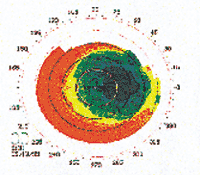 |
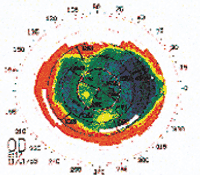 |
|
| Intacs create a steeper center and a flatter periphery in the cornea, resulting in a prolate surface that improves both the quality and the quantity of vision. | ||
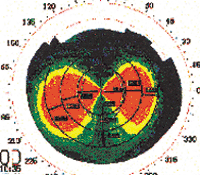 |
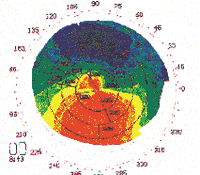 |
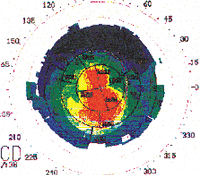 |
| Topographic maps show how Intacs implantation reduces corneal ectasias and keratoconus induced by LASIK. | ||
For Your Information:
- Michiel S. Kritzinger, MD, can be reached at the Visiomed Eye Laser Center of Johannesburg, South Africa, P.O. Box 727, Cresta, 2118 South Africa; +(27) 476-3113; fax: +(27) 476-1929; e-mail: mskritz@icon.co.za; Web site: www.visionmed.co.za. Dr. Kritzinger has no direct financial interest in any of the products mentioned in this article, nor is he a paid consultant for any companies mentioned.
